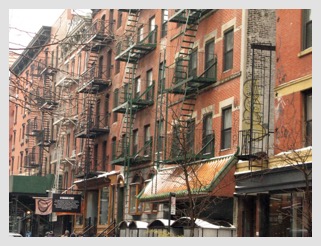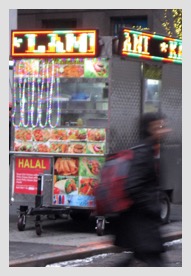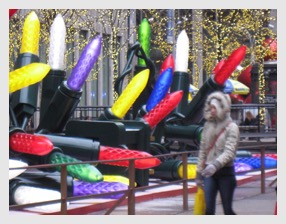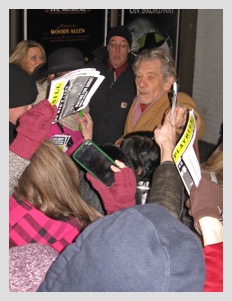New York
January 1-6, 2014
It had been awhile since I’d been in New York, still this January might not have been the ideal time to go for all kinds of reasons--money, weather, work calendar--but there was an even more powerful confluence of opportunities that pushed me to go ahead and make the trip.
First, there was the partial reprise of The Armory Show of 1913, an art show, a cultural watershed, part of the moment in which the United
States moved from high Victorian to Marcel DuChamp and Matisse in the blink of an eye. I study and write about this era in American history, especially on the labor movement in the US, and this transition fascinates me.
Second, Patrick Stewart and Ian McKellen were playing together in “Waiting for Godot” (Brecht) and “No Man’s Land” (Pinter), a once-in-a-lifetime opportunity.
Then there were all the things on the perpetual “bucket list” for NYC, things that have no particular deadlines, but that need to be given some urgency or they’ll never get done.
And there was the opportunity to spend some time with my brother Alex and to see my friend Larry.
On January 1, I arrived in NYC and made my way to Alex’s place in Brooklyn. I had attended to the weather forecasts and had brought only one pair of shoes, a pair of waterproof hiking boots. I also forsook my fashionable leather jacket for my more practical 3-in-1 parka. Alex and Shawna and I went to a late brunch in Brooklyn, and Alex and I spent a quiet evening at his place watching movies, talking, and enjoying Indian carry-out that evening, so my wardrobe choices weren’t much of an issue.
The next day, though, I headed back to Manhattan for my theatre double-header: the matinee performance of “Waiting for Godot” and “No Man’s Land” that evening at 8. I just tried to seize the upper hand, looking more suited to the north woods of Minnesota than to Manhattan, and to carry it off as if I knew I was on the advance wave of fashion. By the time I went to supper that evening, I was looking very smart, and by the next day, waterproof hiking boots and parkas were all the rage in NYC.
NYC had not completely dismantled Christmas when I arrived. There was still a smattering of holiday decoration around Manhattan, but there was no evidence of the approximately one million people who attended the New Year’s Eve celebration two nights prior.
As I was on my way out the door that morning, Alex gave me Shawna’s number and suggested that she and I might enjoy supper together between my shows. I started texting her that afternoon before my first show. I had just met Shawna for the first time on this trip; she seemed to have a good sense of humor, so with tongue in cheek, an exaggerated display of southern gallantry, not dishonest, just a bit hyperbolic, I sent the following message:
Dunno what your schedule is like today, but I’d love it if you’d be my guest for supper. Next to being seen in the company of a beautiful man, nothing escalates a gay man’s stock more than being seen in the company of beautiful woman. ;-)
There were a couple of follow-up messages with the same playful mode. When, after the afternoon performance, I hadn’t heard anything back from Shawna, I sent a text to Alex. The number he had given me was one digit off. I called Shawna, and we met for a rather hurried supper at a Japanese restaurant somewhere around 55th Street. Later that night, I received the following text from the number I had been messaging all day:
Sorry, but you have the wrong number. I wish i could come but i am in a nursing home I am 86
Whether or not I was being spoofed on the reply or not, it was very funny.
Both “Godot” and “No Man’s Land” sparkled. Stewart and McKellen were clearly having a rollicking good time. And “Godot” was visually stunning, the precision with which the two of them pulled off some of the choreography. I need to read “No Man’s Land.” It strikes me that, in
the little snippets of criticism I have read, no one addresses the issue of power, which seems to me to be key to the play. The power relationships shift throughout the play as different facets of or types of power are brought into play: intellectual power, brute physical power, the power of money, the power of fame, the power that substances exercise over us.
By the time “No Man’s Land” was over that evening, the snow was really coming down and the build up was already considerable. I felt sorry for Bill de Blasio, who had only been mayor for 24 hours and was probably not going to get any sleep that night. NYC must have very strict shoveling ordinances. As I made my way back to Alex’s that night, people all over the neighborhood were out in the falling snow at midnight clearing their walks.
I had resolved to make this a leisurely trip, as much as one can be leisurely in NYC. I limited myself to one scheduled activity per day. Friday was dedicated to the
Armory Show of 1913 at the New York Historical Society. I made my way to the upper west side and went in search of lunch. Yelp! pointed me to what turned out to be a Chinese-Peruvian restaurant. I drew a Peruvian waiter who recommended the Peruvian half of the menu, but the senior management and most of the clientele seemed to be Chinese.
The neighborhood around Central Park was swarming with kids, out of school, with their plastic snow saucers, like giant Frisbees, searching for any hill with room to slide down.
The Armory Show was fascinating. I never found anyone who could tell me if it was planned in conjunction to the Armory Show, lending context and contrast, but there was a small exhibit of portraits from the Gilded Age also at the New York Historical Society. I took in that exhibit before heading on to the main event. Quite unexpectedly, I came upon a portrait of the foremost American orator of the fin de siècle, Robert Ingersoll, posed with his grandchildren.
The curators of this centennial reprise of the Armory Show designed to display the paintings and sculptures in the order in which visitors would have seen them in 1913 and in similar groupings. What was most notable was how this show, so revolutionary in its impact, tried to stress the continuity between the new art of DuChamp, Matisse, et al., and their forebears. Artists, who were shattering conventions, were being presented as the natural extension of earlier, familiar painters and sculptors. I need to find out more about who was responsible for this rhetorical strategy and what their thinking was. Wherever the strategy came from, and whatever the thinking was behind it, it did not quell the controversy. Duncan Phillips, who would later found the first museum in the US to be devoted exclusively to modern art, lamented, “As I write, the air of studios in New York is charged with much talk about painting, talk that is full of fanaticism and mystification and real concern for the future of art … an International Exhibition of Modern Art quite stupefying in its vulgarity.”
The Chicago Evening Post found in the show evidence that “the great confusion,” which had overwhelmed literature years prior, had now overtaken painting and sculpture: “The ‘classic’ standards or criticism have broken down and been wholly abandoned.” No less a figure than Theodore Roosevelt felt compelled to weigh in on the show, calling the artists represented in the show “extremists” and noting that change, while necessary to life, could also mean death and “retrogression instead of development.”
As darkness fell, I made my way in the now biting cold to meet my long-time friend Larry for supper at Crispo on W 14th Street. Larry is an unerring guide to excellent dining, and this night was no exception.
This was maybe my first trip to New York in the smart phone era. I may have had a smart phone on my last trip, though I doubt it. I certainly didn’t have a smart phone with all of the apps that I have today. It made a world of difference as I navigated from place to place on the Metro, searched for places to eat, etc. One morning, while Alex was still sleeping, I got up, found a grocery near his apartment in Brooklyn that seemed likely to have products I was looking for, and went out to lay in breakfast supplies. Smart phones have taken much of the adventure out of travel; they make every place familiar. Something is lost, to be sure, but much is gained.
Saturday, I went down some blocks from Alex’s apartment to pick up some slices of pie at Four-and-Twenty Blackbirds. I left those slices at Alex’s apartment for us to enjoy later, and I went on to lunch at
Der Kommissar, an Austrian style sausage restaurant of which Alex is a co-owner. Der Kommissar had its moment of fame back during the first Anthony Wiener sexting scandal. Wiener represented this area of Brooklyn. Alex, who is a PR genius, had a promotion, two hot dogs for $8, “Anthony’s wieners.” This stunt got Alex and the restaurant on Wolf Blitzer’s segment of the evening news. Happily, the food at Der Kommissar was very good, not just the sausages, but the homemade sauerkraut, made with red cabbage, and the potato salad.
After lunch, my plan for the afternoon was a
Magritte retrospective at MoMA. My friend Henry had given me tickets, which proved to be a very good thing. I have never seen such crowds at an art museum, crowds more akin to what I’d associate with Coney Island or Six Flags, hordes of people. With my pass, however, I was sped through the admission process and made my way quickly to the Magritte exhibit. It was huge. I had no idea. I was familiar with many of the most famous Magritte paintings--“Time Transfixed,” “The False Mirror,” “The Son of Man,” “Ceci nest use pipe”--but I was overwhelmed by the range and variety of work in this exhibit.
After the Magritte, I made my way back to Brooklyn. Alex was working that night. I found a fish and chips joint in his neighborhood and afterwards, stopped in at a local gay bar where Alex used to work.
Sunday, my last full day, I scheduled a visit to the
Tenement Museum. I first heard about the Tenement Museum some years ago and on my ffirst trip to NY after hearing about it, I thought I’d

pay a visit. Again, this is an era of US history that I’ve been involved with professionally, teaching and writing about labor movements and the conditions of poor people in the Gilded Age and the Progressive Era. My expectation was that I would find some lonely docent who, not having had a visitor in weeks, would eagerly grab me by the arm and give me a personal tour. Not so. On that visit, all tickets were sold out days in advance. For this trip, I actually joined the museum and booked three of its several tours for Alex and me. The centerpiece of the Tenement Museum is a tenement house on Orchard Street (lower East Side) built in 1863. The building served as a tenement house until, I believe it was 1938 when it was closed, the costs of keeping up with housing codes having become too great for the landlords to justify. The businesses on the ground floors remained open, but the upper floors were vacant until it was purchased in 1988 with the purpose of turning it into a museum to commemorate the experience of NYC’s working class people from the mid-19th to the early 20th centuries.
One of the most interesting features of the Tenement Museum is that the curators have restored different areas to reflect different stages of the building’s life. Each tour, approximately 90 minutes, focuses on a different aspect of the building’s history (and there is one walking tour of the neighborhood). Alex and I did a tour covering the building’s earliest residents, the mid-19th-century Irish and the walking tour of the neighborhood. It was icy and still snowing some, but our docent for the walking tour was unflappable. After lunch, Alex went on to watch football and “yell at the TV screen” with Shawna and friends. I did two more tours at the building: one of the businesses that operated on the ground floors, and one of an Italian family’s apartment from the last years that the building operated as a tenement. In the case of the Italian family, they had actually been able to locate one of the daughters who lived in the apartment and had restored the apartment, in part, based on her memories.
After the Tenement Museum, I made my way to Greenwich Village and the historic Stonewall Inn where I had a drink and waited for Alex. We went out for supper, then back to Brooklyn.
Monday, I had a 3:30 flight out of Newark. I left early, hoping to have time to have lunch at Penn Station before getting on the New Jersey RR train, but it was 90 minutes from Brooklyn to Penn Station, serious delays on the Metro. The New Jersey RR was on time, but when we arrived at Newark, the Skytrain had broken down, and we had to be bused to the terminals. The woman at the Delta counter who checked me in, in response to my complaints about my trip to the airport, said, “Well, at least you made it in time for your flight,” indicating that many other had not that day. I was participating in what would prove to be simply the first wave of the transportation snarl that has plagued the Midwest, the Northeast, and the South this winter.
Photos of my New York trip can be found
here (or by clicking the NYC 2014 Photos tab). To view photos as a slideshow, double click the first photo, then use the navigation arrows on the upper left-hand corner of the screen to scroll through the album.




